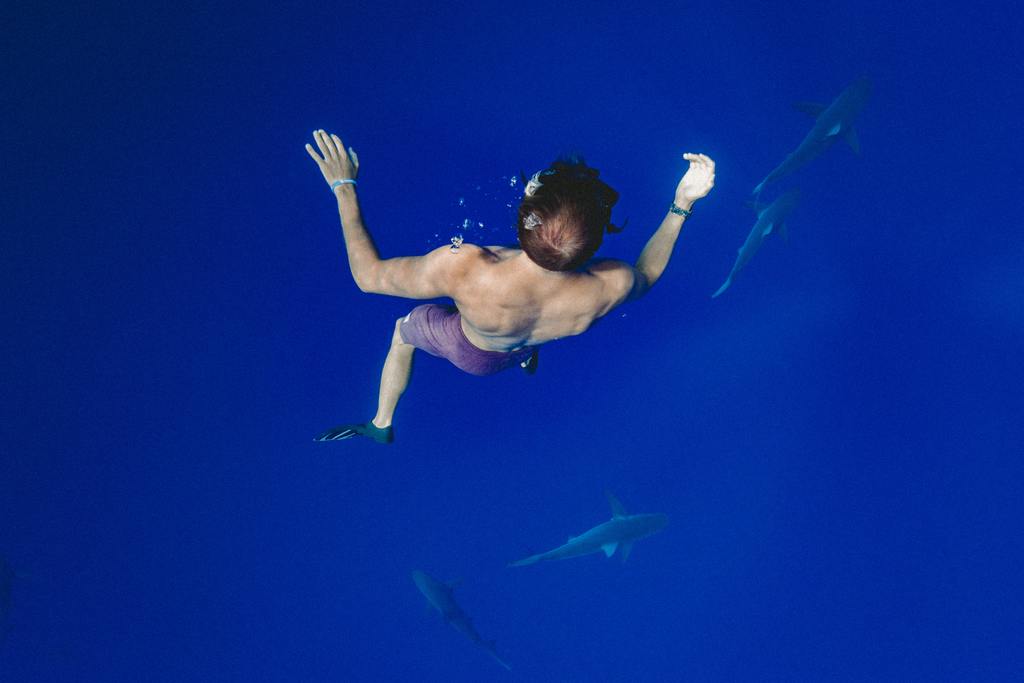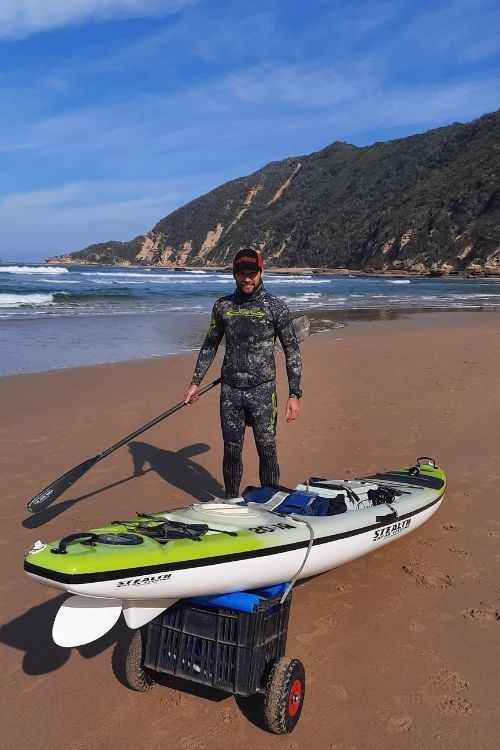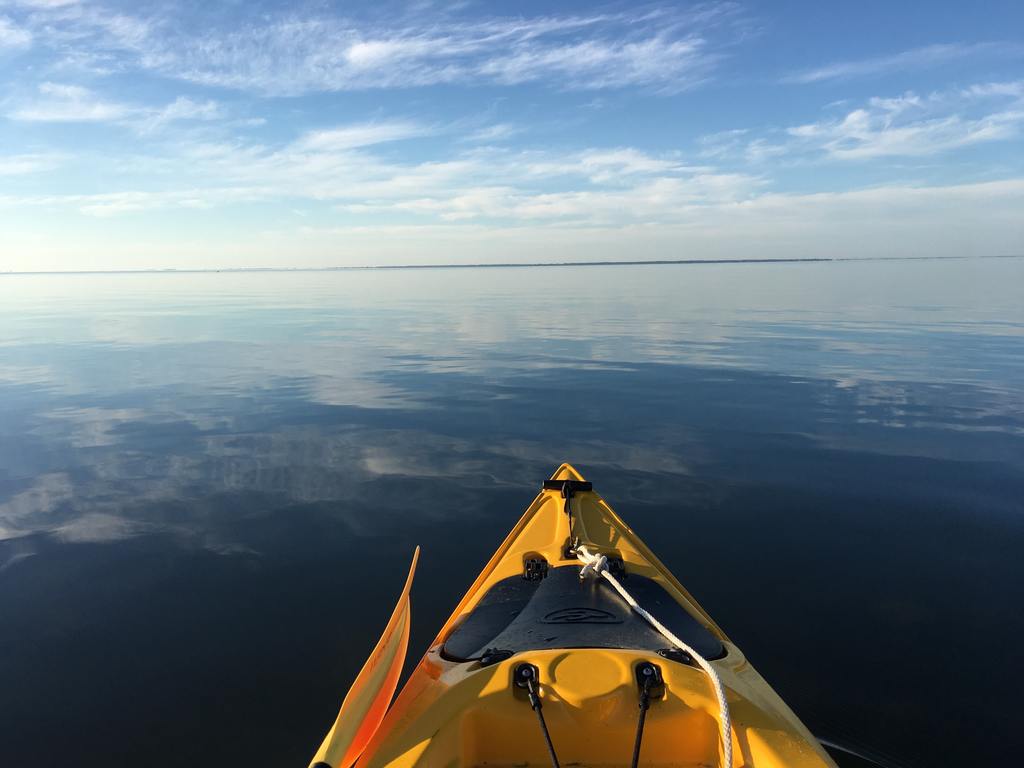Let's be honest, shore diving has got its limits. Some reefs are simply too far to swim to and having a safe mobile platform to rest on and dive from does give you a lot of peace of mind.
But, at the same time not everyone can afford a boat and do boat dives all the time. That's where a spearfishing kayak comes in.
Spearfishing from a kayak seems like a good compromise between the two with benefits from both but also with some disadvantages and unique challenges.
A spearfishing kayak is definitely not for everyone though.

Some spearo's would see the "unique challenges" as well… a challenge to accept. While others will think it is just plain silly, dangerous or even a waste of time and energy.
Both sides have valid points and we have the pleasure of diving into this topic, having a look at the merits, facts and to empower you to decide whether kayak spearfishing is for you.
The pros and cons of spearfishing from a kayak
Long before boats were around people used dugout canoes and basic sailing boats to get to their fishing grounds. Many of these did not just fish from their boats but also freedived from it to collect food and spear fish.
As motorized boats became more popular less and less freedivers relied on their own power to get to the just out of reach reefs.
Now, due to the growing consciousness about living healthy and making environmentally friendly choices freediving and spearfishing from a kayak is making a comeback.
But still, freediving and spearfishing from a kayak does have many disadvantages to counter the advantages. Let's have a look at both of the most common ones:
You can go further and stay out longer with a kayak
While you won't be able to go quite as far(or as fast) as you would with a boat you will be able to go further with a kayak then you would when shore diving. By using your kayak as a platform to rest and recharge on you will also be able to stay out much longer.
When you spearfish from a kayak you can move between reefs much quicker than swimming.
If one reef is not delivering just jump back on your kayak and paddle to the next.
Save base when the water is sharky
This is a big advantage for us but might be less important for you if the area you dive is less shark invested. Keeping bleeding fish out of the water in your kayak's hatch is already a big plus and will result in less sharks being attracted to your spot. If they still do show up and you feel threatened by them you can just jump on your kayak and get out of their way. Still, a kayak is not a boat and great whites are known for taking big bites out of surf skis..

Photo by Derek Owens - Freediving with sharks
Great exercise
Spearfishing and freediving is already a great workout. When you add paddling to the mix you get a whole body workout. Rowing a kayak or canoe does require a certain amount of fitness. Before you jump in and paddle out to distant reefs make sure that you'll have the strength to make it back. This rule rings true for shore diving as well but the advantage with a kayak is that you can take a rest out of the water if needed.
Multipurpose
Many spearos also fish with a rod and reel and having a kayak means that you can also now combine the two. Most fishing kayaks come with rod holders pre-installed and even if it doesn’t it is still quite simple to fit one. It does mean that you will need to carry some extra fishing gear with you but you will also have a greater chance of going home with a fish or even catching some burly on your way to your chosen dive site. Trolling a lure or some bait behind you while paddling out and back takes very little extra effort and the zip sound of a fishing reel is just as exciting as the zip sound that your gun reel makes when a big fish takes off.

Environmentally friendly
With motor boats being reliant on fossil fuels a human powered kayak is a great environmentally friendly alternative. With a spearfishing kayak there is no risk of fuel and oil spills and no exhaust fumes polluting the clean ocean air.
Don't need a license/permit for it
In most countries you need a license to skipper a boat. You might also need to do annual inspections and certifications on your boat to keep it legal. This varies a lot from country to country and even in boat length or engine size so be sure to check with your local authority to verify what licenses, certifications or permits you would need. As far as we know there's no country that requires you to carry a special license to commandeer your kayak even if you take it out on the ocean. All you need is the will to and some common sense.
It does not have an engine
Think we are stating the obvious here…? Normally a kayak does not have an engine and is propelled forward by rowing with an oar/paddle.
If you go for one of the new Hobie Mirage kayaks or Native Watercraft Propel Fishing Kayak then you will get a pedal drive instead. Kayaks with a pedal drive system leaves your hands and arms free to take photographs or to hold on to your fishing rod since you will be using your legs to propel the vessel forward similar to cycling.
There are exceptions nowadays but generally you will be the engine of your kayak. It might depend on the style of your kayak but it should be possible to install a small jetdrive or electric motor in your kayak.
Having an engine even a small electric one does help a lot and if your budget allows and it makes sense for you then you can install one in your spearfishing kayak. It’s always nice to have a back-up power supply to get out of trouble or help you along when your energy is low. Bear in mind that if you do you will might need to register it as you would with a boat depending on the length of your kayak and the HP of the engine. Again, check with your local authorities to make sure.
Slower than a boat
A kayak is much slower than a boat even with the above mentioned engine. This is something that you need to keep in mind and plan for. Getting to a reef that you want to dive and getting out of trouble takes a lot of time. Less than when shorediving but still much more than with a boat and with your kayak you’ll probably be much farther out.
Can't take a friend with unless...
A kayak has very limited space. On a boat you can invite a number of friends to join you but if you have a single kayak then you will be paddling solo. It's never a good idea to dive alone so do pair up with other spearo's that like to spearfish from a kayak. Lashing two single kayaks together when you get to your dive spot makes for a big and stable diving platform. A double kayak with enough space for the gear of two divers can also work well.
Can be difficult to enter without practice
Entering a boat (without a boarding ladder or low transom) in deep water can be tricky. Doing the same with a much narrower and less stable kayak is a whole different story. That is why kayak selection is critical. Read more on how to choose a spearfishing kayak further below.
Also have a look at the KayakGuru's article on how to get in a kayak.
Rules against taking certain fish and shellfish from a vessel.
Some countries have rules against using a vessel to harvest certain species. A vessel can be anything from a spearo float board to a motorboat and kayak. In other places you just require a special permit to do that.
For example in some countries you cannot collect certain species of crayfish while diving from a vessel and you can't use a vessel to get it back to shore not even a float-board.
Check with your local authority to make sure that you won't be breaking any rules by spearfishing and harvesting shellfish.
What to look for in a Spearfishing Kayak
An off the shelf fishing kayak will in most cases be good-enough to spearfish from but there are things that you need to look out for to make your chosen vessel better than a kayak that someone that only fish with a rod would choose.
Easy to enter and stable
With kayaks and canoes it is usually a trade off between speed and stability. The flatter and wider the hull the more stable the kayak will be but they will also be slower because of this.
Hull speed, drag and design are complex topics that are sadly not our area of expertise. All we can say is that as a freediver using a kayak stability is more important than speed.
Fishing kayaks are normally very stable and even allow fisherman to stand upright when casting and fishing.
A wider stable kayak also makes entering it from the water much easier.
Sit inside or sit on top..?
If you are going to use the kayak for spearfishing then it should really be a sit on top rather than a sit inside.
Although a sit inside will likely provide you with a more comfortable and efficient ride it will be very difficult to re-enter it in deep water once you have gone for a dive.
A good sit on top kayak will be much easier to get back into at the end of your dive. Where a sit inside have a lot of space below deck a sit on top has just as much space on the open deck.
Self bailing
It is pretty standard to have scupper holes on sit on top kayaks. If you prefer a drier ride and you are not worried about taking on water then you can use scupper plugs to close the holes.
Sit inside kayaks can have a sprayskirt to keep the cockpit dry but if they fill up due to capsizing then you will have to bail the water with a bucket or a bilge pump.
Hatches and gear stowage
Your chosen kayak should have plenty of space for your spearfishing gear and all the fish that you will be spearing on your outings. You are likely to be carrying more gear than the average kayak fisherman so be sure that the kayak can handle the weight of you and your gear.
Sit on top fishing kayaks usually have a number of hatches to store gear and usually also an open tank well at the back. This tank well is the perfect spot to fit a crate with your gear inside or to just secure it with bungees.
If your kayak has a large fish hatch then you can store your speargun and other valuable gear inside the hull of the kayak. This is especially helpful when you are beach launching your kayak through the surf. If you don't have waves and capsizing to worry about then you can secure your speargun or polespear to the deck or sides. As always, be sure you have the spear tips covered and pointing in a safe direction.
Rudder or skeg.
Contrary to popular belief a skeg and rudder on a kayak is actually more to help keep the kayak tracking straight then it is there to help it to steer. Paddling a kayak without a skeg/rudder in a crosswind is a pain, believe us. The waves and wind will push you around as a kayak naturally wants to turn into the wind. That is Ok if you want to head in that direction but from our experience it is almost never the case.
A rudder is not always something that comes standard with a kayak and you might need to buy this separately.
Spearfishing Kayak Setup
As with most other hobbies a kayak is only the start of it and you will need to add some accessories to make your experience more enjoyable and safe.
Some of these are nice to haves while others are must haves when spearfishing from a kayak.
A PFD
A personal flotation device(PFD) is a must when paddling in a kayak. As a freediver you're probably very comfortable in the water and a strong swimmer but a live vest is always a good idea. Remember that even the best swimmers can't swim after they are knocked unconscious by their paddle or boat in a freak wave.
An Anchor
Once you get to your dive spot and jump in the water you will need to make sure that your kayak doesn’t float off without you. A small kayak anchor and some line will make sure that it doesn’t. You can just throw it overboard and clip it onto one of your handles but that is not ideal in a fast moving current. Rather install a line that run from your bow to stern and that will allow the anchor rope to run between the two. This will ensure that your kayak is always inline with the tide or current.
Float line with bungee
An alternative to using an anchor is to use your kayak like a giant spearfishing float and pull it along behind you. Install a bungee between your kayak and your normal float line to take some of the bounce and tug out of it. A float line also doubles as a tow line in case you or a friend need some help getting back to land.
Diver below flag
To signal other boats that there’s a diver down below you will need to fly the internationally recognized “diver below” flag.
There are two versions of this in use. The blue and white alpha flag and the red and white diver down flag.


Both flags above have the same meaning and indicate to other boats that they should give a wide berth for the safety of the diver and the dive boat which may not be able to move around.
Dry bag for electronics
They call it a dry-hatch but they aren’t always 100% dry. To be safe - especially if there's a risk of capsizing - it's a good idea to put your Cellphone, car keys and anything else that hates water in a small drybag before placing it one of your hatches. If you are confident that your hatches will remain dry after a capsize then something as simple as a ziplock bag is enough.
Getting into a kayak in deep water does not only increase your risk of toppling over your boat but also guarantees that your soaking wet body will get everything on your kayak wet.
Fish finder
This is a very nice to have but not essential. Using a fish finder can show you where the active reefs are and also how deep they are. This is in combination with a GPS can be very useful if you don't know the area that you will be diving but if you are diving familiar spots it is not really necessary.
They vary a lot in price and quality.
Snacks and drinks
One of the great benefits of spearfishing from a kayak is that you can carry extra water with you to re-hydrate after your dive and fuel to recharge your body after a strenous dive. Personally we like to drink Rehydrate at least every two hours while diving and more often when paddling while it is hot and humid. For energy we snack on something light but high in energy or even drink a high carb shake. Fruit are good options as well as most of them digest easily.
Remember that what you eat and drink will affect your breath hold and diving so choose wisely.
Best Spearfishing Kayaks
As you will see from our list a popular fishing kayak isn't necessarily a good spearfishing kayak. And as with all things what works for one person might not be the best for others.
Still, here are our top 3 kayaks - and to be safe we covered all our bases.
The first option is more suited to the avid spearo and kayak fisherman that paddles out through moderate swell and surf, while the last kayak is more suited for those freedivers that just want to dive and shoot some reef fish in calm coastal waters and don't care much about a fishing rod.
Our second option is a safe middle ground or allrounder. It's a good choice for a pure spearo/freediver, kayak fisherman and recreational paddler.
Here the top 3:
Ocean Kayak Trident 13
The Ocean Kayak Trident 13 and it bigger brother the Trident 15 are true fishing machines and can even handle moderate ocean swells. It's comfortable and fast enough to spend the whole day on the water.
Spearos will appreciate the following features:
Vibe Kayaks Sea Ghost 130
We're hoping that this kayak got its name from scaring fish out of the water and into your lap...
This kayak can handle moderate waves in the ocean and offer a good balance of speed and stability. The most notable features of the Sea Ghost 130 kayak is:
Perception Pescador 10
If you're only venturing out and diving in calm coastal waters and not than into fishing from your kayak as well then the 10 foot Perception Pescador kayak will work fine for you.
It's 3 foot shorter than the other kayaks on our list but is also less expensive. The combination of stability and fun makes this one of the best selling fishing kayaks but not necessarily the best spearfishing kayak.
Spearfishing from a kayak can open a whole lot of additional opportunities for you and could result in you getting in the water more and landing more fish.
As you can see from the photo below we love the adventure of spearfishing and freediving from a Kayak. The trip below involved dragging the kayak about a mile on the beach with our home made Kayak dolly before launching. It was slow going through thick loose sand on the walk back which made it tough and slow-going but still 100% worth it.
Who loves adventures...?

Do you use a kayak to spearfish or freedive from..? Tell us about it in the comments below.
If you found value in this article then please share it with your friends.










